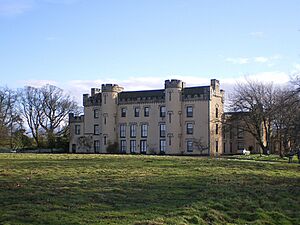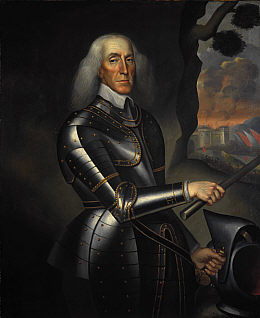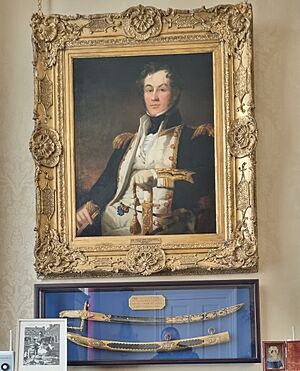House of the Binns facts for kids
The House of the Binns, often called simply the Binns, is a special historic house and estate in West Lothian, Scotland. It has been the home of the Dalyell family for a very long time. The main parts of the house were built in the early 1600s. In 1944, Eleanor Dalyell gave the house to the National Trust for Scotland. This means it is now protected for everyone to enjoy. The house was also the home of a famous politician, Tam Dalyell, until he passed away in January 2017.
The estate is named after two hills, which are called bens in an old Scottish language called Gaelic. So, "Binns" means "the house of the hills." The house sits in 200 acres (about 80 hectares) of parkland. From here, you can see amazing views of central Scotland. You can look north across the River Forth to the Highlands. To the south, you can see the Pentland Hills. Inside the house, there is a collection of beautiful porcelain, old furniture, and family portraits. These items tell the story of the Dalyell family through many centuries.
Contents
History of the Binns Estate
People might have lived on Binns Hill even in ancient times. Some think it could have been the site of a Pictish fort.
Written records about the "Bynnis" land began in 1335. We know there was a manor house here by 1478. At that time, Archibald Meldrum owned it. In 1599, James Lord Lyndsay owned the estate. He then sold it to Sir William Livingston.
In 1612, a rich man from Edinburgh named Thomas Dalyell bought the estate. Thomas Dalyell was a butter merchant. He made a lot of money by bringing butter from Orkney to Leith. He married the daughter of Edward, Lord Kinloss in 1601. When the Scottish King, James VI, became King of England, Kinloss got an important job in London. Thomas Dalyell became his assistant. This job helped him earn enough money to return to Scotland. He bought "the lands of Bynnis and Croceflattis with the manor place." The Dalyell family has lived there ever since.
Between 1621 and 1630, Thomas Dalyell rebuilt the original house. Some parts of the inside still look like they did back then. This includes the front entrance area and the decoration of the High Hall and King's Room. The King's Room was made hoping that King Charles I would visit, but he never did. These rooms still have some of the oldest decorative moldings in Scotland. Thomas Dalyell's son, General Sir Tam Dalyell, continued to improve the house. He added the first towers and the western part of the building.
General Tam o' the Binns: A Famous Resident
The House of the Binns is most famous because General Sir Tam Dalyell (1615–1685) lived there. General Dalyell was a military leader for both King Charles I and King Charles II. During the English Civil War, he was captured and put in the Tower of London. But he escaped! He then traveled to Russia and fought for the Tsar. People called him "Muscovite De'il" because of his time in Russia.
He came back to Scotland when the king returned to power. He became known as "Bluidy Tam" because he was very strict with the Covenanters in the 1660s. In 1678, he became the main military commander in Scotland. In 1681, he started a new army group at the Binns. He became its first leader. This group, called the Royal Regiment of Scots Dragoons, later became the Royal Scots Greys. This regiment had a very long history.
Many things that belonged to General Dalyell are still at the Binns, including his boots! Some items are linked to old stories about him. One story says that the General played cards with the Devil in this house. Today, in the entrance hall, you can still see the table where they supposedly played. The story says that one night, Tam won the game. The Devil got angry and threw a marble table at him. But it missed and landed in the Sergeants' Pond outside. A marble table was actually found when the pond dried up 200 years later! The cards, a cup, and a spoon, which were supposedly used in the game, are also shown in the house. The General is said to have told the Devil, who threatened to destroy his house, "I will build a tower at every corner to hold down my walls."
From the 1700s to Today
In the 1740s and 1750s, Sir Robert Dalyell, the 4th Baronet, made some big changes. He created a new dining room and the current Laigh Hall. He did this by joining two cellar rooms and making the main ceiling higher. He also added an archway and a new front entrance to the house.
Four of his sons later inherited the house and estate. Today, the house mostly looks like it did after changes in the mid-1700s and early 1800s. In 1810, Robert's son, Sir James Dalyell, hired an architect named William Burn. Burn changed the building to the Scottish baronial style. He added more towers and decorative battlements that looked like a castle. Some of the Gothic decorations on the outside were inspired by the writer Walter Scott, who was a friend of the Dalyell family. Now, the main front of the building has three floors, and the side parts have two floors.
In August 1775, John Graham Dalyell was born and grew up in the house. He was the son of Sir Robert Dalyell, the 4th Baronet. John later became a judge, writer, and expert on old things. He became the 6th Baronet and inherited the estate after his older brother passed away. His brother William Cunningham Dalyell, who was a Royal Navy officer, became the 7th Baronet after John died in June 1851. He also inherited the house. The house then went to his youngest brother, Sir Robert Dalyell, 8th Baronet. After that, it passed to his sister, Elizabeth Grace Cornwall-Dalyell, and then through the female side of the family.
In 1944, Eleanor Dalyell gave the house, its parkland, everything inside it, and money for its care to the National Trust for Scotland. She wanted the "history, legend and memory of the family of Dalyell of the Binns, shall be preserved" for everyone to enjoy. However, the family kept the right to live in the house.
Sir Tam Dalyell (1932–2017), who was a Member of Parliament, lived in the western part of the house. His wife, Kathleen, is now the National Trust's representative for the House of the Binns. She is very involved in taking care of it.
The Parkland at the Binns
The house is surrounded by 200 acres (about 0.8 square kilometers) of parkland. You can reach it by two roads. The current road is on the west side. The main east road has not been used since 1913. The Binns Tower is a special building called a "folly." It is located at the highest point of the park, Binns Hill. It was designed by Alexander Allan in 1826. People say it was built because of a bet with the owner at the time, Sir James Dalyell. On the west side of Binns Hill, there is a woodland garden with paths leading to the tower. Below the steep slope to the southwest of the Tower is General Tam's cave. It is said that he used this cave for quiet thinking.
Besides the tower, the park has other important features. Near the west road, there is an old stables complex that is no longer used. It was built before 1818. There is also a walled garden. This garden was used to grow food until World War II. Later, a company used it to grow trees and shrubs. Some parts were also used to grow flowers for the house. Near the west road, you can also see the remains of an old quarry. This quarry is believed to be from before the 1800s. Also close to the west road is the Sergeant's Pond. General Dalyell built this pond around 1681. It was a place for the horses of the Royal Scots Greys to drink water. The Royal Scots Greys regiment used the pond again in 1935 when they camped at the Binns.
In a valley in the southeast part of the park, there is a ruined chapel from the mid-1800s. It later became a farmer's cottage. A caravan park was set up in 1978 in the valley next to the Errick burn and a small wooded area. This caravan park has since closed.
See also
- Dalyell baronets
- List of National Trust for Scotland properties





